Chickens with Cloudy Eyes: Causes & Treatment
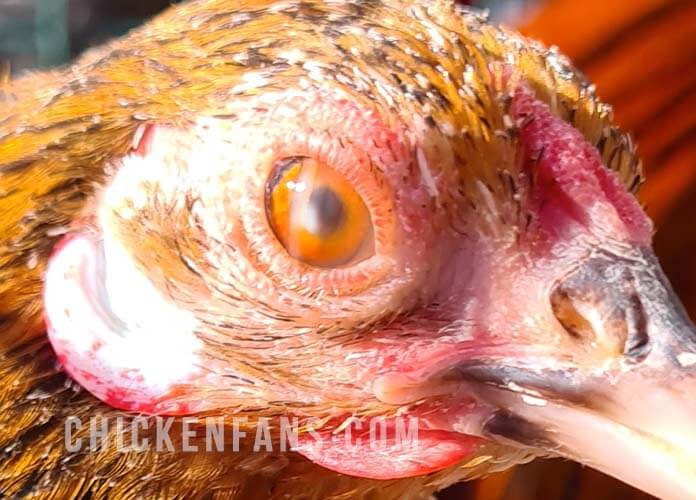

Cloudy eyes can look terrifying in chickens. And with reason. A cloudy eye is a clinical sign of many terrible eye conditions. Should you be worried?
Let’s cover all possible causes:
- Ammonia Blindness
- Infectious Coryza
- New England Disease
- Blindness
- Eye injuries
- Chicken Chlamydia
- Marek’s Disease
- Cataracts
How to provide first aid for cloudy eyes
There are many reasons why a chicken’s eye can look cloudy. But rinsing, washing, and treating an irritated eye will relieve the redness and irritation and helps recovery.
Plenty of over-the-counter products are available to provide first aid and supportive care to ensure instant relief and clear sight.
- Rinse the eye with saline or MicrocynAH Eye Wash to clean the eye. Irrigation of the eye will prevent further infections and helps your chickens see clearly.
- To rinse, turn the chicken on its side and drop the saline solution in the eye. Try to keep the eye open while flushing.
- For eye infections, apply Terramycin 2 to 4 times daily. Terramycin is a broad-spectrum antibiotic treatment.
- Avoid ointments with cortisone as the immunosuppression and hepatopathies negatively affect healing.
We’ll first start with ammonia fumes, a common problem in chicken coops.
1. Ammonia Blindness
Ammonia blindness is the result of eye infections due to ammonia fumes. These fumes have a pungent odor and irritate the eyes and lungs. It’s used in household cleaning products as a degreaser, especially window-cleaning products.
But the fumes are not from cleaning products unless you clean the chicken coop windows with ammonia. They are coming from the chicken droppings.
Ammonia from chicken droppings
Bacteria break down nitrogen in chicken droppings and produce ammonia fumes. Ammonia fumes can’t escape the chicken coop without proper ventilation, with the risk of ammonia concentrations exceeding toxic levels. Chickens that live in confined spaces are highly vulnerable.
The ammonia concentration depends on:
- the size of the chicken coop
- the number of birds
- the type of bedding in the chicken coop
- how frequently the chicken coop is cleaned
- the ventilation of the chicken coop
Long ammonia exposure results in inflammation of the eye and cloudy eyes. Young chicks are especially susceptible. Usually, both eyes are cloudy since the fumes are everywhere.
Ventilation
Especially in the wintertime, proper ventilation is essential. Birds spend more time inside the coop, meaning more droppings and ammonia exposure.
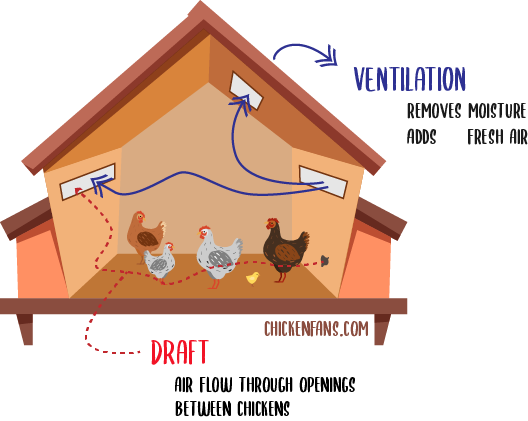
Proper ventilation should always be on top of the chicken coop to prevent the chickens from sitting in draft. An adequate airflow refreshes the air inside the coop, removes evaporated ammonia fumes, and prevents pink and cloudy eyes.
2. Infectious Coryza
Infectious coryza is a worldwide bacterial respiratory disease in chickens. It’s very common since few birds are usually vaccinated for the disease. Most poultry keepers face the disease once in their flock.
Coryza is a contagious disease that will show signs one to three days after infection. It’s spread via contact, contaminated food, or water but can also be transmitted via aerosols in the air. It will roughly last a week with proper treatment.
Symptoms are:
- watery, cloudy eyes due to an eye infection
- foul-smelling pus coming out of the nares and beak of the chicken
- swollen face and wattles
Cloudy eyes can be the first stage, as sometimes the eyes will close completely. Blinded chickens may find it challenging to find their food and water.
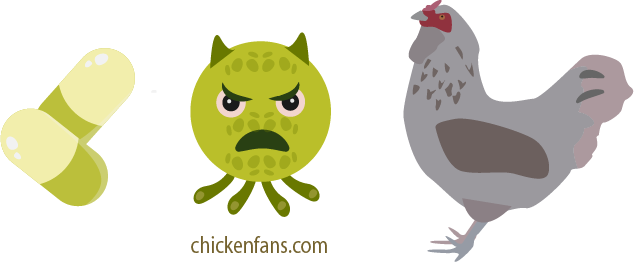
3. New England Disease (Avian Encephalomyelitis)
New England Disease, also called epidemic tremor or avian encephalomyelitis, is a worldwide contagious viral disease that targets the nerves of young chicks. It can infect adult chickens too, but they won’t get sick. It’s most common in unvaccinated backyard chicks.
Symptoms include:
- dull expression
- stumbling around uncoordinated, falling on their sides
- complete paralyzation, lying on the ground
You need to feed and hydrate the chick in severe cases, as they cannot eat and drink.
Cloudy eyes are not a symptom of avian encephalomyelitis in itself, but chicks often develop cataracts when they recover. These cataracts result in cloudy eyes with a blue shine, making it difficult for the chickens to see well. Cataracts can occur weeks after infection.
4. Blindness
Just as humans can be born blind, chicks can hatch blind, too. Or they can become blind due to an injury or disease.
It’s usually quite obvious when the chicks are blind. They will:
- have off-white cloudy eyes
- peck in the air
- bump into everything in the brooder
- behave like they lost track of everything
Blind chicks can still survive, but they have an extra challenge on them.
Gene therapy exists to restore sight in chickens that would normally be born blind. However, it can’t restore eyesight in chicks as it needs to be injected into the eggs before hatching. The cure is not meant for chickens either, as it’s part of research for genetic diseases in human blindness.
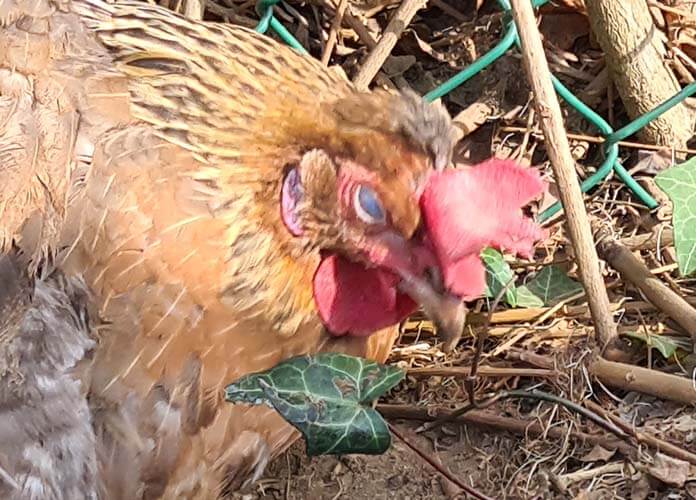
5. Eye injuries
Cloudy eyes can result from an eye injury or a consequent eye infection.
There are multiple possible culprits for eye damage:
- Dirty sand and dust entering the eye
- Insect bites
- Sharp twigs and thornbushes
- A blow from a rooster’s spurs
- A peck from a flock member
Eye injuries are always very tricky and not easy to assess with the naked eye, so it’s best to contact a skilled veterinarian immediately.
6. Chicken Chlamydia
Avian chlamydiosis is a bacterial disease caused by the same bacterium as human chlamydia. It’s widespread in backyard chickens. In severe cases, the disease can be fatal. Chlamydiosis can be treated with antibiotics.
There are many symptoms, and it’s difficult to pinpoint the disease as many strains exist. The most common symptoms are:
- greenish diarrhea
- discharges from the eyes or nares
- eye infections
In case of an eye infection, the chicken can have cloudy eyes due to inflammation. Check our article on eye infections in chickens to see how to treat chlamydia.
7. Marek’s Disease
Marek’s disease is a common, widespread viral disease that can kill many birds in a flock. It infects the nerves and paralyzes a chicken’s legs, neck, and wings. The disease has worsened over the years and can develop cancerous tumors.
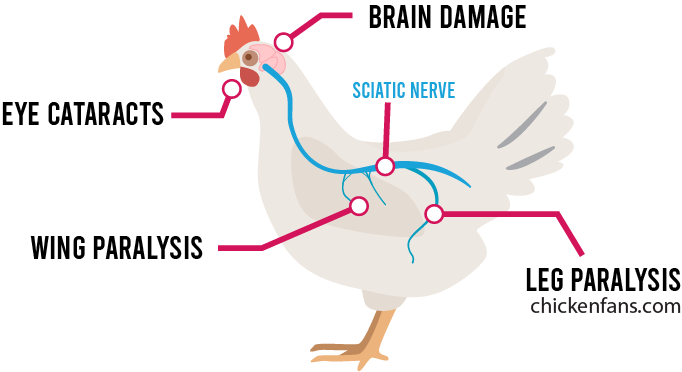
Marek’s Disease comes in two forms; the nervous form causes paralysis. Infection usually starts at the sciatic nerve, rendering the legs and wings unusable, but the infection can progress toward the neck and brain. Ultimately the eye nerves can become infected, growing cataracts that look like cloudy eyes and can turn the chicken blind.
If your chicken has cloudy eyes but none of the other symptoms, chances are slim to none that it’s Marek’s disease.
8. Cataracts
A cataract is a cloudy spot in the lens of the chicken’s eye. It can slowly grow until the chicken becomes blind. In a normal eye, the lens is crystal clear. With cataracts, the incoming light is scattered, and vision becomes blurred.
Cataracts can occur in one eye or affect both eyes of a chicken. When both eyes are affected, the chicken is severely visually impaired until she gets completely blind.
Cataracts can be the result of:
- genetics – some breeds, and especially Brahmas, are genetically predisposed to developing cataracts
- diseases – diseases like New England Disease and Marek’s disease target the nervous system and can result in eye infections and cataracts
- diet – malnutrition in confined spaces can trigger cataracts. A shortage of antioxidants and omega-3 fatty acids can lead to vitamin deficiencies and cataracts.
- ammonia – ammonia fumes irritate the eyes and can lead to eye inflammations resulting in cataracts. Proper ventilation of a chicken coop is vital to prevent eye infections.
9. Aspergillosis
Aspergillosis is a fungal infection of the chicken’s respiratory tract. It is quite common and caused by Aspergillus fumigatus. Chickens get infected when inhaling spores from contaminated feed and litter.
The mold is non-contagious, widespread, and linked to poor hygiene. High ammonia levels in the air, dusty environments, and cold stress increase the risk of infection.
There are two forms of Aspergillosis:
Aspergillosis manifests in two forms:
- Acute Aspergillosis: Develops in young chicks and is also known as brooder pneumonia
- Chronic Aspergillosis: Occurs in adult chickens with weak immune systems
In both forms, it causes:
- Red eyes with discharge
- Cloudy eyes
- Open-beak breathing
- Labored breathing
- Air-gasping
- Loss of appetite
For more information on how to treat Aspergillosis, check our article on eye infections in chickens.
10. Newcastle Disease
Newcastle disease in chickens is a viral disease in the top 5 causes of death worldwide and can attack all systems of a chicken:
- the nervous system
- the respiratory system
- the digestive system
The most common are respiratory issues, where chickens gasp, cough, and sneeze. Not all strains of the virus are severe. Some mild variants of Newcastle Disease don’t have severe manifestations.
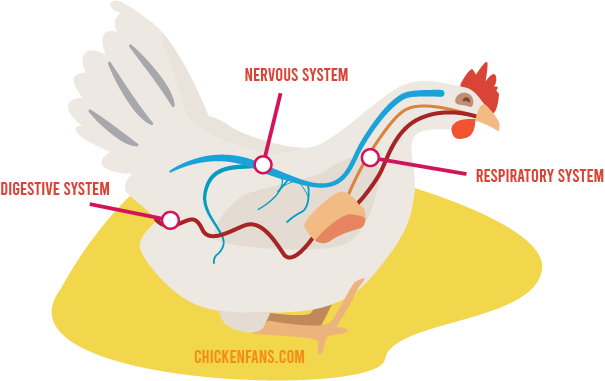
However, virulent Newcastle Disease, the most deadly form of this disease, causes cloudy eyes in chickens.
In this case, the nervous system is also involved, and chickens have severe problems such as:
- tremor, spasms, and shaking movements in one or more parts of the chicken’s body
- difficulty walking, stumbling, and falling on the ground
- paralysis of wings and legs or complete paralysis
- twisted neck and strange head positions
To learn more about the different classifications, symptoms, and treatments, have a look at our in-depth article on Newcastle Disease in chickens.
11. Toxoplasmosis
Toxoplasmosis is a parasitic disease affecting chickens, other animals, and humans. It is caused by a single-celled parasite called Toxoplasma gondii, a coccidia that has cats as its definitive host. Chickens get infected through contaminated water or by exposure to the feces of cats.
Toxoplasmosis in chickens can cause:
- weakness, listlessness
- seizures, convulsions
- incoordination, inability to stand
- cloudy eyes and blindness
- wry neck
- paralysis
The physical signs of toxoplasmosis can vary a lot. Some chickens will show no sign at all, while others will get conditions like lung infections, brain inflammation, blindness, or a swollen spleen.
Summary
Cloudy eyes on a chicken look scary and should be considered a critical sign of illness.
In general, cloudy eyes can result from the following:
- eye injuries and eye infections
- ammonia fumes resulting in inflammation
- dietary issues resulting in cataracts
- multiple diseases affecting the eye nerves
It’s very difficult to diagnose on your own for eye disorders, so we recommend immediately contacting a veterinarian.
To learn more about infections, check our article on eye infections. If you want to read more about chicken health problems, symptoms, and diseases, check out our ‘Health Page‘. You’ll find a ‘Symptom Checker‘, a complete list of ‘Chicken Behavior‘, and an overlook of the most common ‘Chicken Diseases‘. Or go to ‘The Classroom‘ and find a comprehensive list of all Chicken Fans articles.

Dr. M. Tanveer is a licensed veterinarian with several years of experience with chickens. He got his degree from the Faculty of Veterinary and Animal Sciences of the Islamia University of Bahawalpur and has firsthand experience as a veterinarian on broiler breeder farms.



























